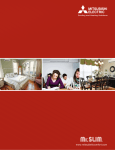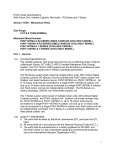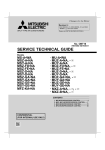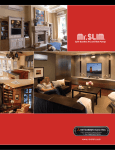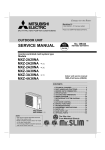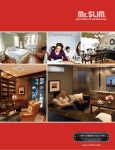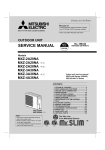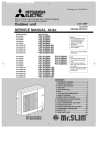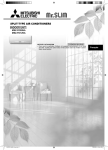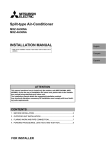Download Mitsubishi Mr.Slim MSZ-D30NA Unit installation
Transcript
P-SERIES AND M-SERIES APPLICATION NOTES P-SERIES A CONTROL WIRING DIAGRAM....................................................................................................................AN-1 MS-A WIRING DIAGRAM.................................................................................................................................................AN-3 MSY-MSZ WIRING DIAGRAM..........................................................................................................................................AN-5 MXZ-2A20NA WIRING DIAGRAM....................................................................................................................................AN-7 MXZ-3A30NA WIRING....................................................................................................................................................AN-10 LOW TEMPERATURE HEATING CHART......................................................................................................................AN-13 P-SERIES TWINNING WIRING DIAGRAM....................................................................................................................AN-15 MXZ-4A36NA WIRING DIAGRAM..................................................................................................................................AN-17 SI-1730-230 WIRING DIAGRAM....................................................................................................................................AN-20 SI-3100-115 WIRING DIAGRAM.....................................................................................................................................AN-22 SI-3100/230 WIRING DIAGRAM.....................................................................................................................................AN-24 DRAIN LINE APPLICATIONS.........................................................................................................................................AN-25 RATED CAPACITY VS MAXIMUM CAPACITY...............................................................................................................AN-28 M-SERIES DRY MODE DESCRIPTION.........................................................................................................................AN-30 M&P-SERIES AIR OUTLET COVERAGE RANGE.........................................................................................................AN-33 M&P-SERIES REMOTE ACCESS..................................................................................................................................AN-36 M-SERIES COOLING CHARTS......................................................................................................................................AN-40 M-SERIES COOLING CAPACITY CORRECTION FACTORS........................................................................................AN-53 M-SERIES COOLING PERFORMANCE DATA..............................................................................................................AN-55 M-SERIES OUTDOOR UNIT CLEARANCES.................................................................................................................AN-58 M&P SERIES HIGH ALITITUDE APPLICATIONS..........................................................................................................AN-67 REGARDING REFRIGERANT ACCESSORIES.............................................................................................................AN-70 P-SERIES INDOOR FAN CYCLE OFF...........................................................................................................................AN-72 SUPPLEMENTAL HEAT CONTROL...............................................................................................................................AN-74 NO SIMULTANEOUS WITH MXZ...................................................................................................................................AN-81 Due to continuing improvement, above specification may be subject to change without notice. Due to continuing improvement, above specification subject to change without notice. Notes (June 2013) 2013may 2013beP-Series and M-Series - Application - Application Notes (June 2013) APP-1 P-Series andUS, M-Series © 2013 2013 Mitsubishi Electric Inc. APP-1 Application Note 1001: P-Series A Control Wiring Diagram ©2012 Mitsubishi Electric US, Inc. Due to continuing improvement, above specification may be subject to change without notice. 2013 P-Series and M-Series - Application Notes (June 2013) APP-2 Indoor unit power is supplied from the outdoor unit. *Use of a disconnect at the indoor unit (part# TAZ-MS303) may be required in your jurisdiction. Use AWG14-3 600 VAC rated copper wiring between outdoor unit and indoor unit for high voltage and control circuits. P-Series units in a CITY MULTI application may only be grouped with P-Series units. Refer to the PAR-21MAA-E technical manual for grouping information. Figure 1 and Figure 2 illustrate available connection patterns. Figure 1. 1:1 System Figure 2. Simultaneous Twin Operation A= Outdoor unit power supply B= Wiring circuit breaker or isolating switch C= Outdoor unit D= Indoor unit/Outdoor unit connecting wiring E= Remote Control F= Indoor unit Note: All wiring shall comply with NEC and local electrical codes. Refer to unit installation manual for more details. August 2009 Application Note 1001 ©2012 Mitsubishi Electric US, Inc. Page |2 Due to continuing improvement, above specification may be subject to change without notice. 2013 P-Series and M-Series - Application Notes (June 2013) APP-3 Application Note 1002: MS-A Wiring Diagram ©2012 Mitsubishi Electric US, Inc. Due to continuing improvement, above specification may be subject to change without notice. 2013 P-Series and M-Series - Application Notes (June 2013) APP-4 1. All MS-A indoor units must be powered from the outdoor unit. (Indoor unit cannot be powered from a separate source) 2. Outdoor unit power is 115 VAC using a two-conductor wire with ground. 3. Indoor unit power is from the outdoor unit from a terminal block marked to the indoor unit. 4. Connect the indoor unit to the outdoor unit on terminals L1, N, 2, and ground. Use copper conductors only. 5. A three pole disconnect switch may be used for shut off or service between the indoor and outdoor unit as shown in Figure 1. Figure 1. 3 pole switch part # TAZ-MS303 CONNECTING WIRES AND CONNECTING GROUND WIRE Use a solid conductor or stranded conductor AWG14. Use doubled insulated copper wire with 300 volt insulation. Use copper conductors only. Follow national and local electrical code. POWER SUPPLY CABLE AND GROUND WIRE Use solid or stranded conductor AWG12** or AWG14 wire. Use copper conductors only. Follow national and local electrical code. Note: All wiring shall comply with NEC and local electrical codes. Refer to unit installation manual for more details. July 2008 Application Note 1002 ©2012 Mitsubishi Electric US, Inc. Page |2 Due to continuing improvement, above specification may be subject to change without notice. 2013 P-Series and M-Series - Application Notes (June 2013) APP-5 Application Note 1003: MSY-MSZ Wiring Diagram ©2012 Mitsubishi Electric US, Inc. Due to continuing improvement, above specification may be subject to change without notice. 2013 P-Series and M-Series - Application Notes (June 2013) APP-6 1. All MSY/MSZ indoor units must be powered from the outdoor unit. (Indoor unit cannot be powered from a separate source) 2. Outdoor unit power is 208/230 VAC using a two-conductor wire with ground. 3. Indoor unit power is supplied from the outdoor unit from a terminal block marked S1, S2, S3. 4. Connect the indoor unit to the outdoor unit on terminals S1, S2, S3 and ground. Use copper conductors only. 5. A three-pole disconnect switch may be used for shut off or service between the indoor and outdoor unit as shown in Figure 1. Figure 1. 3 pole switch part # TAZ-MS303 CONNECTING WIRES AND CONNECTING GROUND WIRE Use a solid conductor or stranded conductor AWG14. Use doubled insulated copper wire with 300 volt insulation. Use copper conductors only. Follow national and local electrical code. POWER SUPPLY CABLE AND GROUND WIRE Use solid or stranded conductor AWG12** or AWG14 wire. Use copper conductors only. Follow national and local electrical code. Note: All wiring shall comply with NEC and local electrical codes. Refer to unit installation manual for more details. July 2008 Application Note 1003 ©2012 Mitsubishi Electric US, Inc. Page |2 Due to continuing improvement, above specification may be subject to change without notice. 2013 P-Series and M-Series - Application Notes (June 2013) APP-7 Application Note 1004: MXZ-2A20NA Wiring Diagram ©2012 Mitsubishi Electric US, Inc. Due to continuing improvement, above specification may be subject to change without notice. 2013 P-Series and M-Series - Application Notes (June 2013) APP-8 1. All MSZ indoor units must be powered from the outdoor unit. (Indoor unit cannot be powered from a separate source). 2. MXZ outdoor unit power is 208/230 VAC circuit using a two-conductor wire with ground. 3. Each indoor unit is powered from the outdoor unit from a terminal blocked marked to the specific indoor unit. 4. Connect the indoor unit to the outdoor unit on terminals S1, S2, S3 and ground. Use copper conductors only. 5. A three-pole disconnect switch may be used for shut off or service between the indoor and outdoor unit as shown in Figure 1. Remark: *A disconnect switch may be required at the indoor unit. Check the local code. ** Use a ring tongue terminal in order to connect a ground or AWG 12 wire to terminal block. Figure 1. 3 pole switch part # TAZ-MS303 July 2008 Application Note 1004 ©2012 Mitsubishi Electric US, Inc. Page |2 Due to continuing improvement, above specification may be subject to change without notice. 2013 P-Series and M-Series - Application Notes (June 2013) APP-9 CONNECTING WIRES AND CONNECTING GROUND WIRE Use a solid conductor or stranded conductor AWG14. Use doubled insulated copper wire with 300 volt insulation. Use copper conductors only. Follow national and local electrical code. POWER SUPPLY CABLE AND GROUND WIRE Use solid or stranded conductor AWG12** or AWG14 wire. Use copper conductors only. Follow national and local electrical code. Note: All wiring shall comply with NEC and local electrical codes. Refer to unit installation manual for more details. July 2008 Application Note 1004 ©2012 Mitsubishi Electric US, Inc. Page |3 Due to continuing improvement, above specification may be subject to change without notice. 2013 P-Series and M-Series - Application Notes (June 2013) APP-10 Application Note 1005: MXZ-3A30NA Wiring ©2012 Mitsubishi Electric US, Inc. Due to continuing improvement, above specification may be subject to change without notice. 2013 P-Series and M-Series - Application Notes (June 2013) APP-11 1. All MSZ indoor units must be powered from the outdoor unit. (Indoor unit cannot be powered from a separate source). 2. MXZ outdoor unit power is 208/230 VAC circuit using a two-conductor wire with ground. 3. Each indoor unit is powered from the outdoor unit from a terminal blocked marked to the specific indoor unit. 4. Connect the indoor unit to the outdoor unit on terminals S1, S2, S3 and ground. Use copper conductors only. 5. A three-pole disconnect switch may be used for shut off or service between the indoor and outdoor unit. (3 pole switch part # TAZ-MS303) Remark: *A disconnect switch may be required at the indoor unit. Check the local code. ** Use a ring tongue terminal in order to connect a ground or AWG 12 wire to terminal block. Figure 1. 3 pole switch part # TAZ-MS303 July 2008 Application Note 1005 ©2012 Mitsubishi Electric US, Inc. Page |2 Due to continuing improvement, above specification may be subject to change without notice. 2013 P-Series and M-Series - Application Notes (June 2013) APP-12 CONNECTING WIRES AND CONNECTING GROUND WIRE Use a solid conductor or stranded conductor AWG14. Use doubled insulated copper wire with 300 volt insulation. Use copper conductors only. Follow national and local electrical code. POWER SUPPLY CABLE AND GROUND WIRE Use solid or stranded conductor AWG12** or AWG14 wire. Use copper conductors only. Follow national and local electrical code. Note: All wiring shall comply with NEC and local electrical codes. Refer to unit installation manual for more details. July 2008 Application Note 1005 ©2012 Mitsubishi Electric US, Inc. Page |3 Due to continuing improvement, above specification may be subject to change without notice. 2013 P-Series and M-Series - Application Notes (June 2013) APP-13 Application Note 1006: Low Temperature Heating Chart ©2012 Mitsubishi Electric US, Inc. Due to continuing improvement, above specification may be subject to change without notice. 2013 P-Series and M-Series - Application Notes (June 2013) APP-14 Heat Pump Capacities Model Number 55° F 45° F 35° F 25° F 15° F 5° F 0° F 12,700 15,800 21,000 23,900 27,000 11,200 14,000 18,500 21,300 23,900 9,600 12,000 15,900 18,400 20,500 8,200 10,200 13,500 15,800 17,400 6,700 8,400 11,100 12,700 14,300 5,575 6,900 8,525 8,400 11,125 5,012 5,975 7,287 7,000 9,537 22,000 31,150 22,000 27,880 19,000 24,610 16,500 21,340 14,000 18,070 11,500 14,880 10,250 13,247 20,000 28,000 34,000 38,000 48,000 18,600 25,360 31,400 36,200 44,000 16,800 22,020 28,400 32,200 39,000 14,600 18,680 25,400 28,200 34,000 12,600 15,340 22,400 24,200 29,000 10,600 12,000 19,400 20,200 24,000 9,600 10,333 17,900 18,200 21,500 M-Series MUZ-A09NA MUZ-A12NA MUZ-A15NA MUZ-A17NA MUZ-A24NA Multi-Zone MXZ-2A20NA MXZ-3A30NA P-Series PUZ-A18NHA PUZ-A24NHA PUZ-A30NHA PUZ-A36NHA PUZ-A42NHA BTU calculated at 70 degree F intake air dry-bulb temperature. All specifications and calculations subject to change without notice. July 2007 Application Note 1006 ©2012 Mitsubishi Electric US, Inc. Page |2 Due to continuing improvement, above specification may be subject to change without notice. 2013 P-Series and M-Series - Application Notes (June 2013) APP-15 Application Note 1007: P-Series Twinning Wiring ©2012 Mitsubishi Electric US, Inc. Due to continuing improvement, above specification may be subject to change without notice. 2013 P-Series and M-Series - Application Notes (June 2013) APP-16 1. Only 24,000 and 36,000 BTU units can be twinned. 2. The two indoor units must equal the capacity of the outdoor unit when added together. 3. Indoor units must be in the same conditioned space since the two return air temperature sensors will be averaged for the space temperature control. 4. The indoor units must be powered from the outdoor unit in a daisy chain fashion as shown in Figure 1. Note: * A disconnect switch (part# TAZ-MS303) may be required by local code at the indoor unit. ** Use a ring tongue terminal to connect ground wire and AWG 12 wire to terminals. Figure 1. Simultaneous Twin Operation A= Outdoor unit power supply B=Wiring circuit breaker or isolating switch C= Outdoor unit D= Indoor unit/Outdoor unit connecting wiring E= Remote Control F= Indoor unit CONNECTING WIRES AND CONNECTING GROUND WIRE Use a solid conductor or stranded conductor AWG14-3. Use doubled insulated copper wire with 600 volt insulation. Use copper conductors only. Follow national and local electrical code. POWER SUPPLY CABLE AND GROUND WIRE Use solid or stranded conductor AWG12** or AWG14 wire. Use solid or stranded conductor AWG14 wire only on S3 communication terminal. Use copper conductors only. Follow national and local electrical code. Note: All wiring shall comply with NEC and local electrical codes. Refer to installation manual for more details. August 2009 Application Note 1006 ©2012 Mitsubishi Electric US, Inc. Page |2 Due to continuing improvement, above specification may be subject to change without notice. 2013 P-Series and M-Series - Application Notes (June 2013) APP-17 Application Note 1008: MXZ4A36NA Wiring Diagram ©2012 Mitsubishi Electric US, Inc. Due to continuing improvement, above specification may be subject to change without notice. 2013 P-Series and M-Series - Application Notes (June 2013) APP-18 1. All MXZ indoor units must be powered from the outdoor unit. (Indoor unit cannot be powered from a separate source) 2. MXZ outdoor unit is powered 208/230 VAC in a two-conductor wire with ground. 3. Each indoor unit is powered from the outdoor unit from a terminal block marked to indoor unit. 4. Connect the indoor unit to the outdoor unit on terminals S1, S2, S3 and ground. Use copper conductors only. 5. A three-pole disconnect switch may be used for shut off or service between the indoor and outdoor unit. The 3 pole switch part # TAZ-MS303 is shown in Figure 1. Remark: * A disconnect switch may be required. Check the local code. ** Use a ring tongue terminal in order to connect a ground wire to terminal. Figure 1. MXZ-4A36NA Wiring March 2008 Application Note 1008 ©2012 Mitsubishi Electric US, Inc. Page |2 Due to continuing improvement, above specification may be subject to change without notice. 2013 P-Series and M-Series - Application Notes (June 2013) APP-19 CONNECTING WIRES AND CONNECTING GROUND WIRE Use a solid conductor AWG14 or stranded conductor AWG18, AWG16, or AWG14. Use doubled insulated copper wire with 300 volt insulation. Use copper conductors only. Follow national and local electrical code. POWER SUPPLY CABLE AND GROUND WIRE Use solid or stranded conductor AWG14 wire. Use copper conductors only. Follow national and local electrical code. Note: All wiring shall comply with local electrical codes. March 2008 Application Note 1008 ©2012 Mitsubishi Electric US, Inc. Page |3 Due to continuing improvement, above specification may be subject to change without notice. 2013 P-Series and M-Series - Application Notes (June 2013) APP-20 Application Note 1009: SI-1730-230 Wiring Diagram ©2012 Mitsubishi Electric US, Inc. Due to continuing improvement, above specification may be subject to change without notice. 2013 P-Series and M-Series - Application Notes (June 2013) APP-21 Figure 1 illustrates the SI-1730-230V Wiring Diagram for Mitsubishi Electric MiniSplit Systems. Figure 1. SI-1730 -230V Wiring Diagram August 2009 Application Note 1009 ©2012 Mitsubishi Electric US, Inc. Page |2 Due to continuing improvement, above specification may be subject to change without notice. 2013 P-Series and M-Series - Application Notes (June 2013) APP-22 Application Note 1010: SI-3100-115 Wiring Diagram ©2012 Mitsubishi Electric US, Inc. Due to continuing improvement, above specification may be subject to change without notice. 2013 P-Series and M-Series - Application Notes (June 2013) APP-23 Figure 1 illustrates the SI-3100-115V Wiring Diagram for Mitsubishi Electric MiniSplit Systems. Figure 1. SI-3100-115V Wiring Diagram August 2009 Application Note 1010 ©2012 Mitsubishi Electric US, Inc. Page |2 Due to continuing improvement, above specification may be subject to change without notice. 2013 P-Series and M-Series - Application Notes (June 2013) APP-24 Application Note 1011: SI-3100-208/230 Wiring Diagram ©2012 Mitsubishi Electric US, Inc. Due to continuing improvement, above specification may be subject to change without notice. 2013 P-Series and M-Series - Application Notes (June 2013) APP-25 Figure 1 illustrates the SI-3100-208/230V Wiring Diagram for Mitsubishi Electric Mini-Split Systems. Figure 1. SI-3100-230V Wiring Diagram August 2009 Application Note 1011 ©2012 Mitsubishi Electric US, Inc. Page |2 Due to continuing improvement, above specification may be subject to change without notice. 2013 P-Series and M-Series - Application Notes (June 2013) APP-26 Application Note 1012: Drain Line Applications ©2012 Mitsubishi Electric US, Inc. Due to continuing improvement, above specification may be subject to change without notice. 2013 P-Series and M-Series - Application Notes (June 2013) APP-27 Use PVC piping for the drain line. When connecting the PVC piping, use adhesive to attach the supplied drain socket. Ensure that the drain line (pipe) is properly routed through the wall hole and inclined downwards (away from the indoor unit) as shown in Figure 1. The end of the drain line (pipe) must be lower than the drain outlet of the indoor unit. Ensure that there are no peaks and valleys in the run of the drain line that may cause trapped drainage. Do NOT install traps in the drain line. Ensure that the discharge end of the drain line is NOT submerged in water in a drainage ditch or receptacle. Ensure that there is more than 2” (5cm) between the end of the drain line and any obstacles that may impede free flow of condensate. When pipework is completed, check to make sure that water flows from the end of the drain pipe freely and ensure that water is not leaking from the drain pipe connections. Figure 1. Condensate drain pipe connection November 2009 Application Note 1012 ©2012 Mitsubishi Electric US, Inc. Page |2 Due to continuing improvement, above specification may be subject to change without notice. 2013 P-Series and M-Series - Application Notes (June 2013) APP-28 Application Note 1013: Rated Capacity vs. Maximum Capacity ©2012 Mitsubishi Electric US, Inc. Due to continuing improvement, above specification may be subject to change without notice. 2013 P-Series and M-Series - Application Notes (June 2013) APP-29 “Rated Capacity” is the system output capacity observed at standard AHRI rated testing conditions (47°F, and 17°F outdoor for heating). AHRI testing, performed to AHRI-210/240, requires the compressors to be run at a constant speed (60Hz) due to testing limitations. Any advantage gained by variable speed equipment is not exhibited in the test results. The test result values are listed in the AHRI Directory of Certified Product Performance, which is accessible through the AHRI website. These values are also listed and identified in all Mitsubishi Electric HVAC published resources, including brochures, technical documentation, and the website. “Maximum Capacity” is the actual output capacity units will produce when trying to achieve set point condition (selected room temperature) from relative load condition (current room temperature). The greater the load requirement, the more the capacity increases until maximum capacity of the unit is reached. Maximum Capacity was equal to Rated Capacity before the introduction of inverter drive variable-speed compressor systems. Maximum Capacities are also listed and identified in all Mitsubishi Electric HVAC published resources. Example: MSZ-FE12NA, 12,000 BTU/h Heat-pump System Rated Heating Capacity at 47°F = 13,600 BTU/h Rated Heating Capacity at 17°F = 8,300 Btu/h Maximum Heating Capacity at 17°F = 13,600 BTU/h January 2010 Application Note 1013 ©2012 Mitsubishi Electric US, Inc. Page |2 Due to continuing improvement, above specification may be subject to change without notice. 2013 P-Series and M-Series - Application Notes (June 2013) APP-30 Application Note 1014: M-Series Dry Mode Description ©2012 Mitsubishi Electric US, Inc. Due to continuing improvement, above specification may be subject to change without notice. 2013 P-Series and M-Series - Application Notes (June 2013) APP-31 Mitsubishi Electric/HVAC Division offers air conditioning equipment specifically for thermal comfort conditioning. While the units are designed for cooling and in the case of Heat Pumps for heating and not for humidity control there is a function to reduce the latent content in the air. Dry Mode is the operating mode for Mr. Slim and CITY MULTI indoor units used to reduce the moisture content of the air in the conditioned space served by the indoor unit – without significantly reducing the room temperature. The reduction is accomplished by reducing the airflow across the indoor coil and controlling the temperature of the coil surface so that the surface remains slightly below the dew point of the return air. The coil temperature is maintained by a combination of time based compressor or LEV – Linear Expansion Valve – operation, temperature output information from the smart coil and room temperature sensor input. Dry Mode is available on all of the Mitsubishi/HVAC indoor units and is selectable on Mr. Slim M or P Series via the unit’s Remote Controller (Wired or Wireless) or in the case of CITY MULTI by the local controller, central controller (G-50A/GB-50) or the TG-2000 software. Dry Mode is selected by pressing the MODE button until the display reads “Dry”. Then from the SET TEMP buttons the desired space temperature is selected to control room comfort. To use Dry Mode the room temperature must be greater than 65°F. In Dry Mode, the indoor fan runs on very LOW speed during compressor operation (Mr. Slim 1:1 Systems) or when the LEV is open (Mr. Slim Multi Zone or CITY MULTI Systems.) The fan speed cannot be changed using the remote controller while in Dry Mode. Operation is a combination of time based cooling related to setpoint and space temperature. An example of the operating sequence is shown in Table 1. Table 1. An example of the operating sequence CITY MULTI Indoor LEV THERMOSTAT ROOM TEMP ON OFF CALLING 82° or more 9 Minutes 3 Minutes CALLING 79° - 82° 7 Minutes 3 Minutes CALLING 75° - 79° 5 Minutes 3 Minutes CALLING 64° - 75° 3 Minutes 3 Minutes CALLING less than 64° -Always SATISFIED 64° or more less than 64° 3 Minutes -- 10 Minutes Always Dry mode establishes the refrigerant flow such that the coil temperature is low enough to condense the water vapor in the air but minimize reduction of the air temperature. This is a cumulative action so the air becomes dryer with each pass of the air through the coil. July 2009 Application Note 1014 ©2012 Mitsubishi Electric US, Inc. Page |2 Due to continuing improvement, above specification may be subject to change without notice. 2013 P-Series and M-Series - Application Notes (June 2013) APP-32 The relationship between the room temperature and the set temperature in Dry Mode is shown in Figure 1. Figure 1. The relationship between room temperature and set temperature Dry Mode uses the same coil frost prevention (defrost) as the Cool Mode to eliminate ice on the coil. July 2009 Application Note 1014 ©2012 Mitsubishi Electric US, Inc. Page |3 Due to continuing improvement, above specification may be subject to change without notice. 2013 P-Series and M-Series - Application Notes (June 2013) APP-33 Application Note 1015: M&P-Series Air Outlet Coverage Range ©2012 Mitsubishi Electric US, Inc. Due to continuing improvement, above specification may be subject to change without notice. 2013 P-Series and M-Series - Application Notes (June 2013) APP-34 Table 1. Air Outlet Coverage Range for MSZ-A & MSY-A Table 2. Air Outlet Coverage Range for MSZ-FD Table 3. Air Outlet Coverage Range for MSZ-D The air coverage range is the figure up to the position where the air speed is 1 ft/sec., when air is blown out horizontally from the unit properly at the High speed position. The coverage range should be used only as a general guideline since it varies according to the size of the room and furniture arranged inside the room. The air coverage range is the figure up to the position where the air speed is 1 ft/sec., when air is blown out horizontally from the unit properly at the High seed position. The coverage range should be used only as a general guideline since it varies according to the size of the room and furniture arranged inside the room. The air coverage range is the figure up to the position where the air speed is 1 ft/sec., when air is blown out horizontally from the unit properly at the High speed position. The coverage range should be used only as a general guideline since it varies according to the size of the room and furniture arranged inside the room. July 2009 Application Note 1015 ©2012 Mitsubishi Electric US, Inc. Page |2 Due to continuing improvement, above specification may be subject to change without notice. 2013 P-Series and M-Series - Application Notes (June 2013) APP-35 Table 4. Air Outlet Coverage Range for P-Series The air coverage range is the value up to the position where the air speed is 0.8 ft/sec. when air is blown out horizontally from the unit at the Hi notch position. The coverage range should be used only as a general guideline since it varies according to the size of the room and the furniture inside the room. July 2009 Application Note 1015 ©2012 Mitsubishi Electric US, Inc. Page |3 Due to continuing improvement, above specification may be subject to change without notice. 2013 P-Series and M-Series - Application Notes (June 2013) APP-36 Application Note 1016: M&P-Series Remote Access ©2012 Mitsubishi Electric US, Inc. Due to continuing improvement, above specification may be subject to change without notice. 2013 P-Series and M-Series - Application Notes (June 2013) APP-37 The Mr. Slim® product line has the capability to be controlled remotely by using the CITY MULTI® Centralized Controllers (AG-150/GB-50/GB-24), TG-2000 or by using an external automation system (Building Management System) using either LonWorks® or BACnet® (Building Automation and Control Networks) . The Centralized Controllers AG-150 and GB-50 can manage up to 50 indoor units and the GB-24 can manage up to 24 indoor units in terms of monitoring, operation, scheduling (daily/annual/weekly), maintenance diagnostics. The units can be controlled individually, in a group or in a collective batch operation. They can control On/Off, operation mode selection (Cool, Heat, Auto (R2-series only), Dry, Fan), temperature setting and air flow direction. Scheduling supports daily, weekly and annual schedules through the licensed operation via the PC browser. Remote controller functions (On/Off, Change Operation Mode and Set Temperature) can be permitted or prohibited from the Central Controller. The Centralized controller has an external input/output the can be used for batch operations such as Start/Stop and Emergency Stop. TG-2000 Integrated System Software enables the building manager to control up to 40 AG-150/GB-50 Centralized Controllers with a maximum of 2,000 indoor units across multiple CITY MULTI® and Mr. Slim® outdoor units. TG-2000 requires a field supplied dedicated networked PC and AG-150/GB-50 software licenses (per AG150/GB-50 per function). The LM Adapter is a communication interface to connect the Mitsubishi Electric made products for M-NET use with the LonWorks® network. The LonWorks® interface requires LMAP03U. The LMAP03U can manage up to 50 indoor units per device. LonWorks® Building Management System (BMS) can be constructed to perform Monitoring/Operation, Scheduling Operations, Interlock Operations and Energy Saving Control. The Centralized Controller (AG-150/GB-50) is not required but is recommended. The BACnetIF software is a communication interface to connect the Mitsubishi Electric made products for M-NET use with the BACnet® network. The BACnet® interface requires the SW-BACnet (PAC-YTG31CDA) software license for each Centralized Controller (AG-150/GB-50) and a field supplied PC with 2 LAN ports running the BACnet IF software. The BACnet IF software can manages up to 10 Centralized Controllers (AG-150/GB-50) connected to a single dedicated PC. The M-NET converter PAC-SF81MA will allow for control of the Mr. Slim® P-Series units when connected to the CITY MULTI® Controls Network (CMCN). The M-NET converter is to be connected to each outdoor unit with connected indoor units. The Mr. Slim® P-Series can receive an external Enable/Disable signal through the connector CN32 or CN51 on the indoor unit. These connectors allow for application such as enabling or disabling the indoor unit based upon an occupancy sensor. The M-NET converter MAC-399IF will allow for control of the Mr. Slim® M-Series units when connected to the CITY MULTI® Controls Network (CMCN). The converter May 2009 Application Note 1016 ©2012 Mitsubishi Electric US, Inc. Page |2 Due to continuing improvement, above specification may be subject to change without notice. 2013 P-Series and M-Series - Application Notes (June 2013) APP-38 is to be used for each indoor unit with connected outdoor unit. The MAC-399IF can only be used with the inverter models of the M-Series (MXZ/MSY/MSZ). Note: The MAC-399IF M-NET converter cannot be used together with the MAC-397IF hard wire MA controller adapter on the same unit. If connection to the Centralized Controller and a hard wired remote controller is needed, use the ME controller for connection to the M-NET. The Mr. Slim® M-Series can receive an external Enable/Disable signal by Breaking S1, S2, and S3 at the indoor unit. Breaking these terminals will allow an automation system the ability to schedule the Mr. Slim M-Series units On/Off. Applications P-Series When the P-Series units are to be integrated into the CITY MULTI® network with the Centralized Controllers the following components are needed: • PAC-SF81MA – M-NET converter (per outdoor unit) • AG-150/GB-50/GB-24 – Centralized Controller When the P-Series units are to be integrated into the CITY MULTI® network with TG2000 the following components are needed: • PAC-SF81MA – M-NET converter (per outdoor unit) • AG-150/GB-50 – Centralized Controller • TG-2000 software • Dedicated PC – Runs TG-2000 software • SW-Mon/SW-Sch – Monitoring and Scheduling software (minimum software required) for each connected Centralized Controller • SW-Charge – Tenant Billing software for each connected Centralized Controller (optional) • When the P-Series units are to be integrated into LonWorks® network the following components are needed: • PAC-SF81MA - M-NET converter (per outdoor unit) • AG-150/GB-50 – Centralized Controller (recommended) • LMAP03U – LonWorks® Interface When the P-Series units are to be integrated into the BACnet® network the following components are needed: • PAC-SF81MA – M-NET converter (per outdoor unit) • AG-150/GB-50 – Centralized Controller • SW-BACnet (PAC-YTG31CDA) – needed for each connected Centralized Controller • BACnetIF software – located on the CITY MULTI Controls Network CD (CMCN CD) • Dedicated PC – PC runs BACnetIF software, must have 2 LAN cards, handles up to 10 Centralized Controllers May 2009 Application Note 1016 ©2012 Mitsubishi Electric US, Inc. Page |3 Due to continuing improvement, above specification may be subject to change without notice. 2013 P-Series and M-Series - Application Notes (June 2013) APP-39 M-Series When the M-Series units are to be integrated into the CITY MULTI® network with the Centralized Controllers the following components are needed: • MAC-399IF – M-NET converter (per indoor unit) • AG-150/GB-50/GB-24 – Centralized Controller When the M-Series units are to be integrated into the CITY MULTI® network with TG2000 the following components are needed: • MAC-399IF – M-NET converter (per indoor unit) • AG-150/GB-50 – Centralized Controller • TG-2000 software • Dedicated PC – Runs TG-2000 software • SW-Mon/SW-Sch – Monitoring and Scheduling software (minimum software required) for each connected Centralized Controller • SW-Charge – Tenant Billing software for each connected Centralized Controller (optional) When the M-Series units are to be integrated into LonWorks® network the following components are needed: • MAC-399IF - M-NET converter (per indoor unit) • AG-150/GB-50 – Centralized Controller (recommended) • LMAP03U – LonWorks® Interface When the M-Series units are to be integrated into the BACnet® network the following components are needed: • MAC-399IF – M-NET converter (per indoor unit) • AG-150/GB-50 – Centralized Controller • SW-BACnet (PAC-YTG31CDA) – needed for each connected Centralized • Controller • BACnetIF software – located on the CITY MULTI Controls Network CD • (CMCN CD) • Dedicated PC – PC runs BACnetIF software, must have 2 LAN cards, handles up to 10 Centralized Controllers May 2009 Application Note 1016 ©2012 Mitsubishi Electric US, Inc. Page |4 Due to continuing improvement, above specification may be subject to change without notice. 2013 P-Series and M-Series - Application Notes (June 2013) APP-40 Application Note 1017: M-Series Cooling Charts ©2012 Mitsubishi Electric US, Inc. Due to continuing improvement, above specification may be subject to change without notice. 2013 P-Series and M-Series - Application Notes (June 2013) APP-41 7-3. Condensing pressure Data is based on the condition of indoor humidity 50%. Air flow should be set at High. A point on the curve shows the reference point. MU-A09WA MU-A12WA July 2009 Application Note 1017 ©2012 Mitsubishi Electric US, Inc. Page |2 Due to continuing improvement, above specification may be subject to change without notice. 2013 P-Series and M-Series - Application Notes (June 2013) APP-42 Cooling Data is based on the condition of indoor humidity 50%. Air flow should be set to High speed. MUZ-A09NA MUZ-A09NA-U1 MUZ-A09NA-1 MUZ-A09NA-U2 July 2009 Application Note 1017 ©2012 Mitsubishi Electric US, Inc. Page |3 Due to continuing improvement, above specification may be subject to change without notice. 2013 P-Series and M-Series - Application Notes (June 2013) APP-43 Cooling Data is based on the condition of indoor humidity 50%. Air flow should be set to set to High speed. MUZ-FD09NA MUZ-A12NA July 2009 Application Note 1017 ©2012 Mitsubishi Electric US, Inc. Page |4 Due to continuing improvement, above specification may be subject to change without notice. 2013 P-Series and M-Series - Application Notes (June 2013) APP-44 Cooling Data is based on the condition of indoor humidity 50%. Air flow should be set to set to High speed. MUZ-FD12NA MUZ-A15NA MUY-A15NA July 2009 Application Note 1017 ©2012 Mitsubishi Electric US, Inc. Page |5 Due to continuing improvement, above specification may be subject to change without notice. 2013 P-Series and M-Series - Application Notes (June 2013) APP-45 Cooling Data is based on the condition of indoor humidity 50%. Air flow should be set to set to High speed. MUZ-A17NA MUY-A17NA MUZ-A24NA MUY-A24NA July 2009 Application Note 1017 ©2012 Mitsubishi Electric US, Inc. Page |6 Due to continuing improvement, above specification may be subject to change without notice. 2013 P-Series and M-Series - Application Notes (June 2013) APP-46 Cooling Data is based on the condition of indoor humidity 50%. Air flow should be set to set to High speed. MUZ-GA24NA MUY-GA24NA MUY-D30NA July 2009 Application Note 1017 ©2012 Mitsubishi Electric US, Inc. Page |7 Due to continuing improvement, above specification may be subject to change without notice. 2013 P-Series and M-Series - Application Notes (June 2013) APP-47 Cooling Data is based on the condition of indoor humidity 50%. Air flow should be set to set to High speed. MUZ-D30NA MUY-D36NA July 2009 Application Note 1017 ©2012 Mitsubishi Electric US, Inc. Page |8 Due to continuing improvement, above specification may be subject to change without notice. 2013 P-Series and M-Series - Application Notes (June 2013) APP-48 Cooling Data is based on the condition of indoor humidity 50%. Air flow should be set to set to High speed. MUZ-D36NA Heating Data is based on the condition of outdoor humidity 75%. Air flow should be set to High speed. Data is for heating operation without any frost. MUZ-A09NA MUZ-A09NA-U1 July 2009 Application Note 1017 ©2012 Mitsubishi Electric US, Inc. Page |9 Due to continuing improvement, above specification may be subject to change without notice. 2013 P-Series and M-Series - Application Notes (June 2013) APP-49 Heating Data is based on the condition of outdoor humidity 75%. Air flow should be set to High speed. Data is for heating operation without any frost. MUZ-A09NA-1 MUZ-A09NA-U2 MUZ-FD09NA July 2009 Application Note 1017 ©2012 Mitsubishi Electric US, Inc. P a g e | 10 Due to continuing improvement, above specification may be subject to change without notice. 2013 P-Series and M-Series - Application Notes (June 2013) APP-50 Heating Data is based on the condition of outdoor humidity 75%. Air flow should be set to High speed. Data is for heating operation without any frost. MUZ-A12NA MUZ-FD12NA July 2009 Application Note 1017 ©2012 Mitsubishi Electric US, Inc. P a g e | 11 Due to continuing improvement, above specification may be subject to change without notice. 2013 P-Series and M-Series - Application Notes (June 2013) APP-51 Heating Data is based on the condition of outdoor humidity 75%. Air flow should be set to High speed. Data is for heating operation without any frost. MUZ-A15NA MUZ-A17NA July 2009 Application Note 1017 ©2012 Mitsubishi Electric US, Inc. P a g e | 12 Due to continuing improvement, above specification may be subject to change without notice. 2013 P-Series and M-Series - Application Notes (June 2013) APP-52 Heating Data is based on the condition of outdoor humidity 75%. Air flow should be set to High speed. Data is for heating operation without any frost. MUZ-A24NA MU-GA24NA July 2009 Application Note 1017 ©2012 Mitsubishi Electric US, Inc. P a g e | 13 Due to continuing improvement, above specification may be subject to change without notice. 2013 P-Series and M-Series - Application Notes (June 2013) APP-53 Application Note 1018: Mr. Slim Cooling Capacity Correction Factors ©2012 Mitsubishi Electric US, Inc. Due to continuing improvement, above specification may be subject to change without notice. 2013 P-Series and M-Series - Application Notes (June 2013) APP-54 Refrigerant piping length (one way : ft.) 25 (std.) 40 65 Model MS-A09WA MS-A12WA 1.0 0.954 0.878 Refrigerant piping length (one way : ft.) 25 (std.) 40 65 100 Model MSZ-A09/12/15/17NA MSY-A15/17NA 1.0 0.954 0.878 MSZ-A24NA MSY-A24NA 1.0 0.95 0.878 Refrigerant piping length (one way : ft.) 25 (std.) 40 65 Model MUZ-FD09NA MUY-FD12NA Model MUZ-D30NA MUZ-D36NA MUY-D30NA MUY-D36NA 0.713 1.0 0.954 0.878 Refrigerant piping length (one way : ft.) 25 (std.) 40 65 100 1.0 0.95 0.878 July 2009 0.713 Application Note 1018 ©2012 Mitsubishi Electric US, Inc. Page |2 Due to continuing improvement, above specification may be subject to change without notice. 2013 P-Series and M-Series - Application Notes (June 2013) APP-55 Application Note 1019: M-Series Cooling Performance Data ©2012 Mitsubishi Electric US, Inc. Due to continuing improvement, above specification may be subject to change without notice. 2013 P-Series and M-Series - Application Notes (June 2013) APP-56 July 2009 Application Note 1019 ©2012 Mitsubishi Electric US, Inc. Page |2 Due to continuing improvement, above specification may be subject to change without notice. 2013 P-Series and M-Series - Application Notes (June 2013) APP-57 July 2009 Application Note 1019 ©2012 Mitsubishi Electric US, Inc. Page |3 Due to continuing improvement, above specification may be subject to change without notice. 2013 P-Series and M-Series - Application Notes (June 2013) APP-58 Application Note 1020: M Series Outdoor Unit Clearances ©2012 Mitsubishi Electric US, Inc. Due to continuing improvement, above specification may be subject to change without notice. 2013 P-Series and M-Series - Application Notes (June 2013) APP-59 July 2009 Application Note 1020 ©2012 Mitsubishi Electric US, Inc. Page |2 Due to continuing improvement, above specification may be subject to change without notice. 2013 P-Series and M-Series - Application Notes (June 2013) APP-60 July 2009 Application Note 1020 ©2012 Mitsubishi Electric US, Inc. Page |3 Due to continuing improvement, above specification may be subject to change without notice. 2013 P-Series and M-Series - Application Notes (June 2013) APP-61 July 2009 Application Note 1020 ©2012 Mitsubishi Electric US, Inc. Page |4 Due to continuing improvement, above specification may be subject to change without notice. 2013 P-Series and M-Series - Application Notes (June 2013) APP-62 July 2009 Application Note 1020 ©2012 Mitsubishi Electric US, Inc. Page |5 Due to continuing improvement, above specification may be subject to change without notice. 2013 P-Series and M-Series - Application Notes (June 2013) APP-63 July 2009 Application Note 1020 ©2012 Mitsubishi Electric US, Inc. Page |6 Due to continuing improvement, above specification may be subject to change without notice. 2013 P-Series and M-Series - Application Notes (June 2013) APP-64 July 2009 Application Note 1020 ©2012 Mitsubishi Electric US, Inc. Page |7 Due to continuing improvement, above specification may be subject to change without notice. 2013 P-Series and M-Series - Application Notes (June 2013) APP-65 July 2009 Application Note 1020 ©2012 Mitsubishi Electric US, Inc. Page |8 Due to continuing improvement, above specification may be subject to change without notice. 2013 P-Series and M-Series - Application Notes (June 2013) APP-66 July 2009 Application Note 1020 ©2012 Mitsubishi Electric US, Inc. Page |9 Due to continuing improvement, above specification may be subject to change without notice. 2013 P-Series and M-Series - Application Notes (June 2013) APP-67 Application Note 1021: M&P Series High Altitude Applications ©2012 Mitsubishi Electric US, Inc. Due to continuing improvement, above specification may be subject to change without notice. 2013 P-Series and M-Series - Application Notes (June 2013) APP-68 When air conditioners and heat pumps are installed in areas above sea level, capacity is reduced due to decreased air density. Equipment size must be increased to meet the load requirements. The following correction factors apply to CITY MULTI and Mr. Slim air conditioners and heat pumps for both heating and cooling operation. The indoor and outdoor units need to be sized based on the capacity reduction due to the decreased air density. Examples: Air-Source System An air-source system installed at 5,000 feet above sea level would operate at 83% its normal capacity when compared to its performance at sea level. Therefore, the indoor unit(s) and outdoor unit(s) need to have at least 17% higher capacity to provide the same cooling and heating performance as the units would at sea level conditions. Water-Source System With a water-source system installed at 5,000 feet above sea level, the indoor units would operate at 83% their normal capacity when compared to their performance at sea level. Therefore, the indoor unit(s) would need to have at least 17% higher capacity to provide the same cooling and heating performance as the units would at sea level conditions. The water-source units can be sized based on their standard capacity at sea level. However, depending on the indoor units selected, the size of the outdoor unit may have to be increased to meet the maximum connected capacity requirement. The maximum connected capacity for PQHY Series is 130%; the maximum connected capacity for PQRY Series is 150%. Table 1 lists the capacity correction factors. Altitude Feet Above Sea Level 0 1000 2000 3000 4000 5000 6000 7000 8000 9000 10000 Table 1. Capacity Correction Factors Air-Source Systems Water Source Systems Indoor Outdoor Indoor Water-Source Unit Unit Unit Unit 1.00 1.00 1.00 1.00 0.96 0.96 0.96 1.00 0.93 0.93 0.93 1.00 0.90 0.90 0.90 1.00 0.86 0.86 0.86 1.00 0.83 0.83 0.83 1.00 0.80 0.80 0.80 1.00 0.77 0.77 0.77 1.00 0.74 0.74 0.74 1.00 0.71 0.71 0.71 1.00 0.69 0.69 0.69 1.00 August 2012 Application Note 1021 ©2012 Mitsubishi Electric US, Inc. Page |2 Due to continuing improvement, above specification may be subject to change without notice. 2013 P-Series and M-Series - Application Notes (June 2013) APP-69 Adjusting equipment size for high-altitude applications is not supported by Design Tool software, so correction factors must be performed manually. No other adjustments are necessary in the system design and application. August 2012 Application Note 1021 ©2012 Mitsubishi Electric US, Inc. Page |3 Due to continuing improvement, above specification may be subject to change without notice. 2013 P-Series and M-Series - Application Notes (June 2013) APP-70 Application Note 1022: Regarding Refrigerant Accessories ©2012 Mitsubishi Electric US, Inc. Due to continuing improvement, above specification may be subject to change without notice. 2013 P-Series and M-Series - Application Notes (June 2013) APP-71 August 21, 2006 MEMO: Refrigerant Accessories Please be advised that we do not recommend the following accessories on our ductless air conditioners or heat pump units. Filter Driers: Our units are made in the factory under clean conditions and are brazed using dry nitrogen. They are charged with clean oil and new refrigerant. When the line sets are attached using flare connections the copper is clean. Under clean conditions filter driers are not necessary and will only cause pressure drops in the system. Sight Glasses: The outdoor unit contains the metering device. The purpose of a sight glass is to check the condition of the liquid refrigerant prior to metering device. Since sight glasses are placed prior to the metering device at the indoor the sight glass would be useless and only create a pressure drop in the lines. Traps: Traps create pressure drops in our systems. They are commonly used to help in oil return to the compressor. Since the velocity of the refrigerant is greater when the metering device is placed in the outdoor unit oil return is not a problem. If a trap is not preventable, it must be a minimum of twelve inches in length. Albert R. Blyler Senior Application Specialist Mitsubishi HVAC July 2009 Application Note 1022 ©2012 Mitsubishi Electric US, Inc. Page |2 Due to continuing improvement, above specification may be subject to change without notice. 2013 P-Series and M-Series - Application Notes (June 2013) APP-72 Application Note 1023: P-Series Indoor Fan Cycle Off ©2012 Mitsubishi Electric US, Inc. Due to continuing improvement, above specification may be subject to change without notice. 2013 P-Series and M-Series - Application Notes (June 2013) APP-73 Figure 1: R410A P-Series Indoor Fan Cycle Off in Heat or Cool Mode with PAR-21MAA Controller Here are the 5 Steps to setting up the PAR-21MAA Controller displayed in Figure 1: 1. Press the airflow up/down (J) button and test (B) button at the same time for two seconds 2. Wait for a few seconds until the small dashes start to flash then press the clock (C) buttons to change refrigerant address to 00 then press the clock on/off (D) button then the clock (C) buttons to change unit number to 01 3. Press the back (E) button then wait for a few seconds until the big dashes start to flash then press the temperature up/down (F) button to change mode number to 25 for heating then the menu (G) button then the temperature up/down (F) button to change the setting number to 2 then press the back (E) button until the number stop flashing now it is set 4. Press the back (E) button then wait for a few seconds until the big dashes start to flash then press the temperature up/down (F) button to change mode number to 27 for cooling then the menu (G) button then the temperature up/down (F) button to change the setting number to 2 then press the back (E) button until the number stop flashing now it is set 5. Press the airflow up/down (J) button and test (B) button at the same time for two seconds to get back to normal display Note: Use of the PAR-21MAA controller with M-series units for fan cycling is not applicable. July 2009 Application Note 1023 ©2012 Mitsubishi Electric US, Inc. Page |2 Due to continuing improvement, above specification may be subject to change without notice. 2013 P-Series and M-Series - Application Notes (June 2013) APP-74 Application Note 1024: Supplemental Heat Control ©2012 Mitsubishi Electric US, Inc. Due to continuing improvement, above specification may be subject to change without notice. 2013 P-Series and M-Series - Application Notes (June 2013) APP-75 The P-Series, SEZ and SLZ indoor units, when installed with MXZ, PUZ or SUZ heat pump outdoor units, can interface and enable supplemental and auxiliary heat sources using an indoor board connector (CN-24 or CN-152, depending on indoor unit). For indoor units connected to PUY outdoor units, external heat control does not function. (Please note that at this time M-Series indoor units (MS/MSZ/MFZ) do NOT support any supplemental heat control or interface capabilities. If supplemental heat control is required, please provide alternate options). Supplemental or auxiliary heat should be sized and selected by the contractor or engineer to provide the necessary capacity to maintain expected comfort in all reasonable low temperature conditions. Any heat source must also be equipped with all required control, safety, and operational devices needed for proper and safe operation. Check your local, state, and federal codes. Table 1 summarizes which style of indoor unit has either a CN-24 or CN-152 connector to interface with supplemental heat sources. Table 1. Indoor Unit Models Requiring CN-24 or CN-152 Connector Applicable Indoor Unit Model PLA-A**BA4 (Ceiling-recessed) PCA-A**KA4 (Ceiling-suspended) SLZ-KA**NA (Ceiling-recessed) PEA(D)-A**AA4 (Ducted) SEZ-KD**NA4 (Ducted) PKA-A**HA4 and PKA-A**KA4 (Wall Mounted) Connector CN-24 CN-152 Requires Part # CN24-Relay-Kit-CM3 which includes: Connector with wiring lead o Colored wires with spade connectors o Kit covers both sizes of CN24 plugs 12 VDC Relay CN22/CN4Y fan speed jumper PAC-SE59RA-E which includes: Connector with wiring lead Box contains connector for CN152 which is a 10-pin Molex type with a 2m 2-conductor wire attached to pins 1 & 2 Also need CN24-Relay-Kit-CM3 August 2012 Application Note 1024 ©2012 Mitsubishi Electric US, Inc. Page |2 Due to continuing improvement, above specification may be subject to change without notice. 2013 P-Series and M-Series - Application Notes (June 2013) APP-76 Supplemental Heat Control via CN-24 for PLA, PCA and SLZ Indoor Units CN-24 controls are indicated in Figure 1and require no setup at the remote controller. This function is only available in heating operation. Figure 1. CN-24 controls Figure 2 illustrates a typical wiring diagram for PLA, PCA and SLZ indoor units using CN-24: Figure 2. Wiring Diagram for PLA, PCA and SLZ Indoor Units using CN-24 Supplemental Heat Control via CN-24 for PEA (D) and SEZ Indoor Units CN-24 controls are indicated in Figure 1 and require no setup at the remote controller. This function is only available in heating operation. This default operation is highly recommended. If desired, the dead-band to energize supplemental heat can be tightened to 1.8° F via remote controller settings. Note: This setting will result in the supplemental heat always being energized any time the indoor unit is actively heating. Via the MHK1 Wireless Remote Controller, enter the Installer Setup Menu and select Setup Function 123 and select setting #2; From the PAR-21MAAU Wired Remote Controller select mode 23 and select setting #2. (Controller manuals currently do not label this action for this function). August 2012 Application Note 1024 ©2012 Mitsubishi Electric US, Inc. Page |3 Due to continuing improvement, above specification may be subject to change without notice. 2013 P-Series and M-Series - Application Notes (June 2013) APP-77 Figure 3. CN4YControls Selecting setting #2 for Setup Function 123 on MHK1 (or Mode 23 on PAR-21MAAU) allows Setup Function 125 on MHK1 (or Mode 25 on PAR21MAA) and CN4Y to be used to control the indoor unit fan during defrost and error conditions as shown in Figure 3. Table 2 and 3 lists the settings to be used to achieve the fan operation desired. Table 2. Fan Operation Settings Depending on Supplemental Heat Location Heater Installed in Duct No heater installed in Duct Use of CN4Y Unused Used Heater is off Fan ON Fan OFF Heater is on Fan ON Fan OFF Mode Fan control Table 3.Controller Settings for Fan Operation Indoor Unit Fan Operation Setup function Mode no. for Heating Setting MHK1 [DEFROST] MHK1 Thermo (PAR-21) or [ERROR] (PAROFF 21) Setting Controller Initial setting Very low Very low 123 (23) 2 125 (25) 1 О Stop Remote controller setting 123 (23) 2 125 (25) 2 · Remote controller setting Remote controller setting 123 (23) 2 125 (25) 3 · August 2012 Application Note 1024 ©2012 Mitsubishi Electric US, Inc. Page |4 Due to continuing improvement, above specification may be subject to change without notice. 2013 P-Series and M-Series - Application Notes (June 2013) APP-78 Figure 4 illustrates a typical wiring diagram for PEA(D) and SEZ indoor units using CN24: Figure 4. Wiring Diagram for PEA(D) and SEZ indoor units Supplemental Heat Control via CN-152 for PKA Wall-mounted Indoor Units CN-152 controls are indicated in Figure 5 and require no setup at remote controller. This function is only available in heating operation. Figure 5. CN-152 Controls Figure 6 illustrates a typical wiring diagram for PKA wall-mounted indoor unit using CN152. Yellow CN-152 Brown Figure 6. Wiring Diagram for PKA Wall-Mounted Indoor Unit August 2012 Application Note 1024 ©2012 Mitsubishi Electric US, Inc. Page |5 Due to continuing improvement, above specification may be subject to change without notice. 2013 P-Series and M-Series - Application Notes (June 2013) APP-79 Wiring restrictions for ALL field wiring in all of the above diagrams: Keep the length of the cable connecting to the circuit board of the indoor unit shorter than 32 ft. (10 meters). Wire size should be 22 ~ 16 AWG (0.5 mm2 ~ 1.25 mm2) depending on length and conditions. All wiring should conform to all local codes and the National Electric Code where applicable. August 2012 Application Note 1024 ©2012 Mitsubishi Electric US, Inc. Page |6 Due to continuing improvement, above specification may be subject to change without notice. 2013 P-Series and M-Series - Application Notes (June 2013) APP-80 Application Note 1025: No Simultaneous Heating and Cooling with MXZ ©2013 Mitsubishi Electric US, Inc. Due to continuing improvement, above specification may be subject to change without notice. 2013 P-Series and M-Series - Application Notes (June 2013) APP-81 Multi-zone (MXZ) heat pump systems can connect two or more indoor units with one outdoor unit. Be advised that multi-zone systems with model numbers that begin with MXZ do not support simultaneous heating and cooling. All indoor units on these type models must all be in the same mode at the same time: either cooling or heating. The entire system will have a mode; individual indoor units set to the opposite mode will be in standby. System Mode The mode of all of the indoor units is determined by the mode of the outdoor unit. The mode of the outdoor unit is determined by the indoor unit that was operating first. Indoor units set to the mode opposite of the outdoor unit cannot operate, and the operation indicator lamp flashes to indicate standby. Example 1 Consider an MXZ system with two indoor units, IDU-1 and IDU-2, both of which are initially set to cooling mode. IDU-1 is switched to heating mode. The outdoor unit will continue to operate in cooling mode until the IDU-2 is switched to heating mode. IDU-2 will still receive cooling to the space, but the IDU-1 will not receive heating to the space. Instead, the remote controller for IDU-1 will indicate standby mode, or indicator light on the unit will flash, depending on the model. When IDU-2 is switched to heating mode, the outdoor unit will switch to heat mode, and both indoor units will receive heating to the space. Example 2 Consider an MXZ system with five indoor units, IDU-1, 2, 3, 4,and 5, which are initially in heating mode. IDU-1, 2, and 3 are switched to cooling mode. The outdoor unit will continue to stay in heating mode, and IDU-1, 2, and 3 will be in standby. The IDU-1, 2, and 3 will not receive cooling until IDU-4 and 5 are switched to cooling mode. IDU-4 is then switched to cooling mode. The outdoor unit will continue to be in heating mode because that was the last mode in which all indoor units were in the same mode. When IDU-5 is switched to cooling mode, the outdoor unit will finally switch to cool mode, and all five indoor units will receive cooling to the space. Forcing System Changeover A forced changeover can be achieved by changing all indoor units to the desired mode. Auto-Mode Indoor units connected to an MXZ system have three mode options: cool, heat, and auto. It is recommended that only heat mode and cool mode be used, and not auto mode. Auto mode is designed for indoor units on one-to-one systems or a VRF simultaneous cooling and heating systems. Because all of the indoor units on multi-zone MXZ systems must be in the same June 2013 Application Note 1025 ©2013 Mitsubishi Electric US, Inc. Page |2 Due to continuing improvement, above specification may be subject to change without notice. 2013 P-Series and M-Series - Application Notes (June 2013) APP-82 mode, having auto mode enabled on the connected indoor units does not guarantee that the system will switch modes when an indoor unit switches modes. Therefore, auto mode does not work as users expect on a multi-zone system, and is not recommended. Simultaneous Heating and Cooling For applications that require simultaneous heating and cooling, Mitsubishi Electric Cooling & Heating offers two options: 1. For smaller applications, multiple one-to-one single-zone systems. 2. For larger applications, CITY MULTI R2-Series systems. R2-Series systems provide simultaneous heating and cooling for up to 50 indoor units connected to one outdoor unit. June 2013 Application Note 1025 ©2013 Mitsubishi Electric US, Inc. Page |3 Due to continuing improvement, above specification may be subject to change without notice. 2013 P-Series and M-Series - Application Notes (June 2013) APP-83



















































































